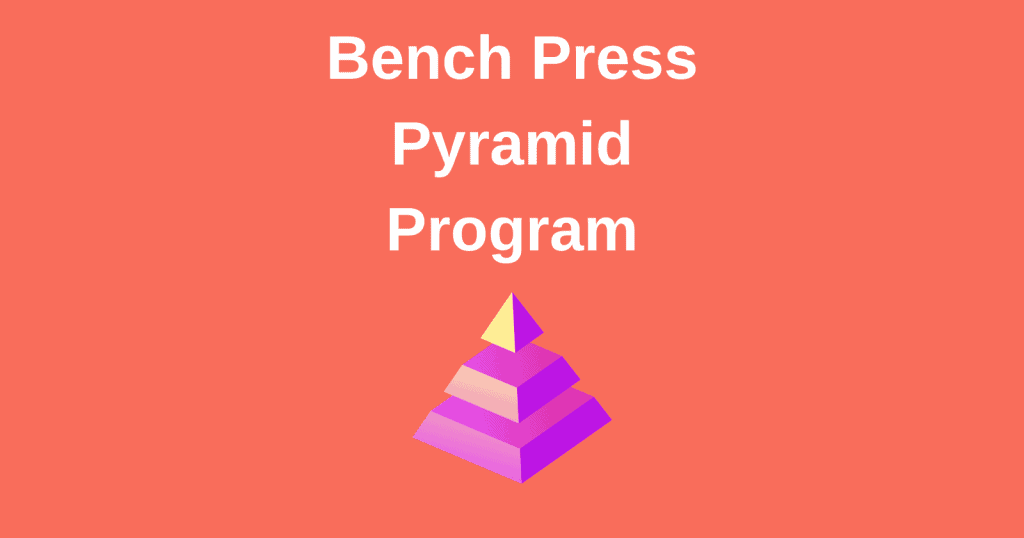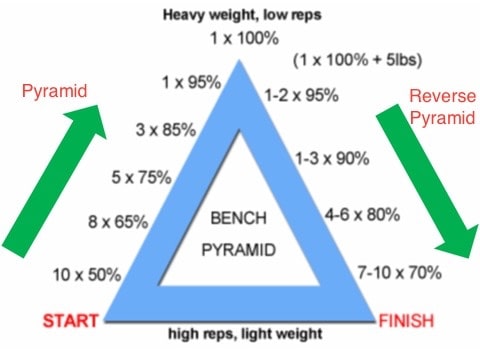
A bench press pyramid is a method of bench press training wherein volume starts high with low intensity and ends low with high intensity. This pyramid shaped change in volume and intensity can occur within a single training session or across multiple training sessions.
Conversely, a descending pyramid stars with low volume and high intensity and ends with high volume and lower intensity.
Table of Contents
Workout Program Overview
This is a bench press program, which means other lifts will need to be programmed separately.
It is essentially a peaking program where you’ll be working up to a new one rep max in the bench press. You could use it for preparing for a powerlifting meet.
- You’ll typically be benching five times per week, but some weeks will have more rest & recovery days.
- The program can be run for anywhere from 4 weeks to 12 weeks.
- The main work of the program revolves around a few exercises:
- Competition bench press
- Slingshot close grip bench press
- Overhead press
- High pin press
- Low pin press
- Accessory movements are up to you and trained at high volume (sets of 20 reps)
- The competition bench movement is trained in triples (sets of 3 reps) and singles (sets of 1 rep).
- The intensity of the bench press sets starts around 70% and gradually increases throughout the program, usually working up to 90% of your one rep max.
Spreadsheets
The spreadsheets here are based upon the program freely shared by Fitness Volt. All credit goes to them, I just made the spreadsheets easier to use.
4 Week Bench Press Pyramid
6 Week Bench Press Pyramid
8 Week Bench Press Pyramid
10 Week Bench Press Pyramid
12 Week Bench Press Pyramid
For a 12 week cycle, simply run the 6 week cycle twice.
Wait. Why is it called Pyramid Training?
If you’re wondering why this is called pyramid training and not… I don’t know, staircase training, so was I.
To me, the term “pyramid” is a little confusing.
It should probably be called a staircase, as many pyramid rep schemes don’t have the lifter going “back down.” Some do, but that is often called “reverse pyramid” training.

For this program, we’re more or less working our way “up” the pyramid, ending the program with a new one rep max attempt.
Depending upon the length of the program, there may be some deloads along the way.
Frequently Asked Questions
At what intensity should I train the alternative pressing movements?
There were no strict intensity guidelines given for the slingshot close grip bench press, overhead press, or pin presses.
Personally, I’d probably use RPE 8.
At what intensity should I train the isolation exercises?
Those movements should not be trained with an intensity above RPE 9. In other words, leave a rep or two in the tank.
These are high volume sets, so make sure you’re starting out light if you’re not used to 20 rep sets.
What are some exercise substitutions for the slingshot, pin presses, etc.?
The slingshot close grip bench press (CGBP) is designed to overload your triceps. In the bench press, the triceps primarily help with the lockout portion of the movement.
Slingshot Close Grip Bench Press Alternatives
So, as an alternative to the slingshot CGBP you could use an intensity overload to boards while using a close grip, which would most closely mimic the slingshot CGBP.
If you don’t have boards or a partner to hold them, you could use Bench Blokz to achieve the same training effect.
More simply, you could train using a standard close grip bench press, but this would not achieve the same overloading effect and would deviate more from the intended program.
Pin Press Alternatives
If you’re unable to perform the high pin press, which also assists with training the lockout and allows you to overload the bench press movement, the floor press is a viable alternative.
Similar to above, the board press is also a viable alternative to the high pin press.
If you’re unable to perform the low pin press, which focuses more on the bottom portion of the bench press (near the chest), then a Spoto press or t-shirt press would be a decent alternative.
Which isolation exercises should I choose?
The isolation exercises you perform should align with your individual weakpoints in the bench press. These can be identified by where you miss when you fail a rep.
The three areas where you can miss a bench press is at the bottom (i.e. off the chest), in the middle, or at the top (i.e. lockout).
As identified in the /r/weightroom “Compendium to Overcoming Weak Points” guide, the associated muscles with these sticking points are as follows:
- Bottom of lift
- Pectorals (chest), anterior deltoids, lats
- Middle of lift
- Anterior deltoids
- Top of lift
- Triceps
And some of the accessories you can do to strengthen these muscle groups are:
- Pectorals (chest)
- Flyes
- Dumbell bench press
- Chest dips
- Anterior deltoids
- Overhead press
- Dumbell front raises
- Arnold press
- Lats
- Pull ups
- T-Bar row
- Chest supported row
- Lat pulldowns
- Triceps
- Tricep dips
- Tricep pull downs
- Diamond push ups
- Tricep extensions
This informed my choices for which isolation exercises you can choose from the dropdown menus. If you’d like different ones, simply overwrite the existing values on the “Input” tab within the spreadsheet after you make a copy.